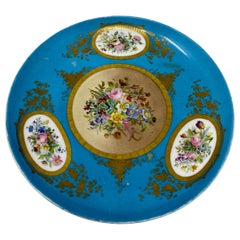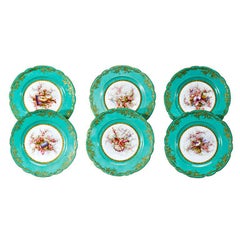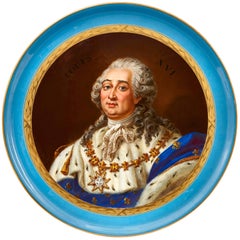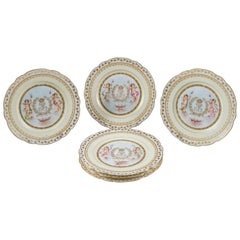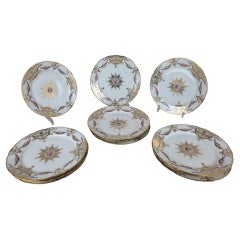Sevres Plates
to
15
125
84
231
14
12
8
7
4
3
3
3
2
2
2
1
1
13
186
32
15
5
3
5
3
1
2
1
2
206
204
49
27
15
213
185
20
19
1
231
231
231
85
3
3
2
2
Sort By
Antique French Early 19th Century Sèvres Plate, circa 1820-1830
Located in New Orleans, LA
Antique French early 19th century Sèvres plate, circa 1820-1830.
FPR007.
Category
Antique Early 19th Century European Porcelain
Materials
Porcelain
Sevres Hand Painted Cabinet Plates, Artist Signed
By Manufacture Nationale de Sèvres
Located in Great Barrington, MA
A magnificent set of 6 19th century Sevres plates with hand painted "Romantic" scenes, each plate
Category
Antique 19th Century French Dinner Plates
Materials
Porcelain
Impressive set of 12 Sevres style porcelain plates, circa 1890
By Cristalleries De Sevres
Located in Brighton, Sussex
This exquisite set of 12 late 19th-century Sevres-style porcelain plates showcases intricate
Category
Antique Late 19th Century French Dinner Plates
Materials
Porcelain
Sèvres Style Porcelain Plate Depicting King Louis XVI
By Manufacture Nationale de Sèvres
Located in London, GB
This exquisite antique porcelain plate was crafted in the style of the famous Sèvres Porcelain
Category
Antique Late 19th Century French Louis XVI Dinner Plates
Materials
Porcelain
Six French Chateau Sevres Porcelain Pink Ground Painted Plates
By Manufacture Nationale de Sèvres
Located in Los Angeles, CA
A very fine set of twelve (12) French Sevres pink ground porcelain painted and jeweled plates
Category
Antique Mid-19th Century French Napoleon III Dinner Plates
Materials
Porcelain
$6,500 / set
H 8.5 in W 8.5 in D 1.5 in
Set of 12 Sèvres Porcelain Plates with Hand-Painted Pastoral Scenes
By Manufacture Nationale de Sèvres
Located in London, GB
Set of 12 Sèvres porcelain plates with hand-painted pastoral scenes
French, c. 1864
Plates: Height
Category
Antique 1860s French Napoleon III Dinner Plates
Materials
Porcelain
$20,651 / set
H 1.19 in Dm 9.06 in
Sèvres, Macé, 12 Porcelain Plates, 19th Century
Located in MARSEILLE, FR
Set of 12 elegant white porcelain plates with a decoration of flowers, ribbons and colored rosettes
Category
Antique 19th Century French Napoleon III Dinner Plates
Materials
Porcelain
19th Century Sèvres Porcelain Dinner Set with Comital Coronet
By Manufacture Nationale de Sèvres
Located in LA CIOTAT, FR
This exquisite 52-piece porcelain dinner service, crafted by Sèvres in the 19th century
Category
Antique 19th Century French Dinner Plates
Materials
Porcelain
Antique Pink Border Hand Painted Paris Porcelain Deer Hunt and Dog Scene Plate
By Manufacture Nationale de Sèvres
Located in Philadelphia, PA
A wonderful antique 19th century Paris porcelain plate.
With a hand painted scene of a hunt
Category
Antique 19th Century French Beaux Arts Dinner Plates
Materials
Porcelain
Exquisite Napoleon Service - Sèvres Porcelain Reissue (1890)
By Saint Amand
Located in LA FERTÉ-SOUS-JOUARRE, FR
Elevate your dining experience with this remarkable Sèvres porcelain service, a prestigious 1890
Category
Early 20th Century French Art Nouveau Dinner Plates
Materials
Porcelain
$7,120 Sale Price / set
20% Off
H 8.27 in Dm 8.27 in
Rare Sevres Art Deco Dinner Service-Jean Luce
By Jean Luce
Located in Great Barrington, MA
Amazing collection of Jean Luce designed and signed Sevres porcelain dinner service. The set
Category
Early 20th Century French Dinner Plates
Materials
Porcelain
French Porcelain Sevres 'Bleu Agate' Part Sevice, Dated 1831
Located in New York, NY
perrywinkle blue ground. Comprising 24 plates and 3 compotes.
Category
Antique 1830s Dinner Plates
Materials
Porcelain
Set of Twelve Sèvres Azure Blue Plates in Their Original Case, circa 1840
By Manufacture Nationale de Sèvres
Located in Brighton, West Sussex
A rare and decorative set of twelve Sèvres Azure blue plates in their original leather fitted case
Category
Antique Mid-19th Century French Tableware
Materials
Porcelain
$9,362 / set
H 9.06 in W 19.69 in D 10.63 in
Six Rococo Sèvres Style Porcelain Plates
By Manufacture Nationale de Sèvres
Located in London, GB
in the style of Sèvres, and gilded rims with ornate patterns inscribed. The centre of each plate is
Category
Antique 19th Century French Rococo Porcelain
Materials
Porcelain
Set of Ten Sèvres-Style Armorial Cabinet Plates
By Manufacture Nationale de Sèvres
Located in Brighton, West Sussex
A Fine Set of Ten Sèvres-Style Armorial Cabinet Plates.
Marked to the reverse with blue
Category
Antique 19th Century French Porcelain
Materials
Porcelain
French Sèvres-style Porcelain Plate in Gilt Bronze Mount
By Manufacture Nationale de Sèvres
Located in Lantau, HK
This French Sèvres-style porcelain plate from the 19th century is set in a gilt bronze mount
Category
Antique 19th Century French Rococo Centerpieces
Materials
Porcelain
Two Sevres Style Porcelain Plates after Titian and Clouet
By Manufacture Nationale de Sèvres
Located in London, GB
', which was pioneered by the Sevres porcelain factory. These plates, which are fine works of art, can be
Category
Antique Late 19th Century French Renaissance Porcelain
Materials
Porcelain
Pair of Sevres Porcelain Plates of Napoleon III and Eugenie
By Manufacture Nationale de Sèvres
Located in Saint-Ouen, FR
"Pair of Sevres Porcelain Plates of Napoleon III and Eugenie"
Pair of plates representing
Category
Antique 19th Century French Napoleon III Porcelain
Materials
Porcelain
A Set of Three 1840's Sevres Porcelain Cabinet Plates
By Manufacture Nationale de Sèvres
Located in Lambertville, NJ
Three Sevres Gilt Heightened Porcelain Cabinet Plates, Mid 19th Century. With scalloped edges, gilt
Category
Antique 1840s Porcelain
Materials
Porcelain
36 Hand Colored and Gilded Plates, 1891-Folio Sevres Porcelaine Vases
By Manufacture Nationale de Sèvres
Located in San Francisco, CA
plates by Gillot, colored and decorated in raised gold by hand.
The sevres porcelain factory produced
Category
Antique Late 19th Century French Late Victorian Books
Materials
Paper
$563 Sale Price
24% Off
H 18 in W 13.5 in D 1 in
Antique French Sevres Porcelain Celeste Blue Gilt Cabinet Plate Centerpiece 19C
By Manufacture Nationale de Sèvres
Located in Dublin, Ireland
An exceptionally well hand painted French sevres style soft paste porcelain circular centerpiece
Category
Antique 19th Century French Victorian Decorative Bowls
Materials
Ormolu
$1,043
H 12.25 in W 12.25 in D 12.25 in
Set of 12, Sevres 19th C., Chateau Des Tuileries 1846 Louis Phillippe Plates
By Manufacture Nationale de Sèvres
Located in Atlanta, GA
exquisite 19th-century porcelain plate set, crafted by the renowned Sèvres manufactory, features an opulent
Category
Antique Mid-19th Century French Louis Philippe Porcelain
Materials
Porcelain
$4,800 Sale Price / set
20% Off
H 0.5 in Dm 9 in
Set of 5 French Sèvres Portrait Plates of Different Ladies of the French Court
By Manufacture Nationale de Sèvres
Located in Boston, MA
Set of five French Sèvres portrait plates, each painted with different ladies of the French court
Category
Antique 1830s French Louis Philippe Decorative Art
Materials
Porcelain
$3,500 / set
H 1 in Dm 9 in
1970s Modern Square Glass Ice Bucket Style of Cristal de Sèvres
By Cristalleries De Sevres
Located in Chula Vista, CA
Crystal Glass Ice Bucket Silver Plate Handle
Square shape with curve around edges.
Clean modern
Category
Vintage 1970s French Mid-Century Modern Barware
Materials
Silver Plate
Ormolu-Mounted Sevrés Style Travel Desk
By Manufacture Nationale de Sèvres
Located in Ciudad Autónoma Buenos Aires, C
Travel desk made with Sevres style porcelain plates, with mercury gold plated bronze mount. The
Category
Antique 1890s French Art Nouveau Desks and Writing Tables
Materials
Gold, Bronze
A Pair of 1800s Ormolu-Mounted French Sevres Style Drum-Shaped Vases and Covers
By Cristalleries De Sevres
Located in Skien, NO
A Pair of Ormolu-Mounted Sevres-Style Drum-Shaped Vases and Covers. With Sevres Marks, from Late
Category
Antique Late 19th Century French Chinoiserie Urns
Materials
Gold Plate, Brass, Bronze
$11,250 Sale Price / set
25% Off
H 24.41 in W 11.42 in D 8.27 in
Gilt Framed Sèvres Bisque Plaque with Cornelian Cabochons and Gilt Bronze Mounts
By Manufacture Nationale de Sèvres
Located in Norwood, NJ
Gilt framed 19th century Sèvres bisque plaque depicting cupid and zodiac with cornelian cabochons
Category
Antique Late 19th Century French Neoclassical Shadow Boxes
Materials
Stone, Gold Plate, Bronze
$1,875
H 30 in W 9.25 in D 1 in
Napoleon III Amphora Shaped Porcelain Sèvre Vase with Bronze Parts
By Manufacture Nationale de Sèvres
Located in Schöfflisdorf, CH
Napoleon III Amphora shaped porcelain in the style of Sèvre vase with bronze parts.
Category
Antique 1870s French Napoleon III Porcelain
Materials
Gold Plate, Bronze
Antique French Ormolu Sevres Style Garniture, 19th Century, Signature and Mark
By Manufacture Nationale de Sèvres
Located in Norton, MA
and the underside of plate with pseudo sèvres mark. Greatest measurement 12.5 inches.
These 3 items
Category
Antique 19th Century French Urns
Materials
Porcelain
$3,245
H 11.75 in Dm 12.5 in
4 Serve style porcelain plates, C19th
By Cristalleries De Sevres
Located in Brighton, Sussex
A good quality set of four late 19th Century Sevres style porcelain plates, each with a turquoise
Category
Antique Late 19th Century French Decorative Art
Materials
Porcelain
19th Century Sevres Porcelain Mounted Side Table / Plater
Located in Brighton, Sussex
). Sevres style porcelain plaques with floral decoration mounted to the frieze, raised on elegant cabriole
Category
Antique 19th Century French Louis XVI Planters and Jardinieres
Materials
Porcelain
Late 19th Century Sevres Style Porcelain Gilt Bronze Plate
Located in Pasadena, CA
late 19th century, this gilt bronze center piece is done in the Sevres XVI style and was made in France
Category
Antique 19th Century French French Provincial Platters and Serveware
Materials
Bronze
Nice Late 19th Century Gilt Bronze and Champlevé Enamel Sèvres Style Centerpiece
By Manufacture Nationale de Sèvres
Located in Long Island City, NY
A nice late 19th century gilt bronze and champlevé enamel mounted Sèvres style centerpiece
The
Category
Antique Late 19th Century French Belle Époque Porcelain
Materials
Bronze, Enamel
$2,500
H 3.5 in Dm 9.5 in
Chateau de Tuileries Sevres Style Hand Painted Cabinet Plate
By Chateau des Tuileries
Located in Guaynabo, PR
This is a Chateau de Tuileries Sevres Style hand painted cabinet porcelain plate. It depicts a
Category
Antique 19th Century French Rococo Decorative Art
Materials
Porcelain
French Sèvres Signed Marked Early 19th Century Porcelain Plate Platter Charger
Located in Studio City, CA
A beautiful early 1800s French Sèvres porcelain oval serving platter/charger/centerpiece. This
Category
Antique Early 19th Century French Porcelain
Materials
Porcelain
$495
H 2.25 in W 20 in D 13.75 in
Antique French Sevres Cabinet Plate Medieval Battle Scene, 19th Century
Located in London, GB
This is a beautiful antique French Sevres porcelain cabinet plate, it bears printed marks for
Category
Antique 1890s French Porcelain
Materials
Porcelain
$378
H 0.99 in W 9.65 in D 9.65 in
Antique French Sevres Porcelain Portrait Plate of Napoleon Bonaparte, Circa 1846
Located in New Orleans, LA
Antique French Sevres Château de Saint-Cloud Porcelain Portrait Plate of Napoleon Bonaparte, Signed
Category
Antique Mid-19th Century French Porcelain
Materials
Porcelain
$1,050
H 1 in Dm 9.5 in
Pair of Antique Sevres Cabinet Plates Mounted as Wall Sconces
Located in Montreal, QC
A pair of antique two-light gilt bronze wall sconces each mounting a Sevres cabinet plate, one
Category
Antique Mid-19th Century French Louis XVI Ceramics
Materials
Bronze
Antique French Sevres Porcelain Portrait Plate of Marie Antoinette, Circa 1846.
Located in New Orleans, LA
Antique French Sevres Château de Saint-Cloud Porcelain Portrait Plate of Marie Antoinette, Signed
Category
Antique Mid-19th Century French Porcelain
Materials
Porcelain
Pair of 19th Century Sevres Porcelain Cabinet Plates : Scenes Gallants
Located in Montreal, QC
faithfulness begs in the background. Each plate is gilt, shaped and within a broad cobalt blue border.
Category
Antique 1840s French Louis XV Porcelain
Materials
Porcelain
$1,250 / set
H 0.75 in Dm 9.38 in
A Fine 19th Century Hand-painted Sevres Porcelain Cabinet Plate & Saucer
Located in Los Angeles, CA
A Fine 19th Century Hand-painted Sevres Porcelain Cabinet Plate & Saucer
Circa 1770
Origin
Category
Antique 18th Century and Earlier French Porcelain
$3,800 / set
H 4 in W 10 in D 10 in
Antique French Sevres Porcelain Gilt Plate "Prise de Valence", 19th Century
Located in London, GB
This is a beautiful antique French Sevres porcelain cabinet plate, dating from the late 19th
Category
Antique 1890s French Porcelain
Materials
Porcelain
$585
H 1.19 in W 9.85 in D 9.85 in
Antique French Sevres Porcelain Cabinet Plate "Camp du Rap" 19th Century
Located in London, GB
This is a beautiful antique French Sevres porcelain cabinet plate, Circa 1880 in date.
It is
Category
Antique 1880s French Porcelain
Materials
Porcelain
$585
H 1.19 in W 9.85 in D 9.85 in
Antique French Sevres Porcelain Portrait Plate of King Louis XV, Circa 1846.
Located in New Orleans, LA
Antique French Sevres Château de Saint-Cloud Porcelain Portrait Plate of King Louis XV, Signed
Category
Antique Mid-19th Century French Porcelain
Materials
Porcelain
Antique French Sevres Porcelain Portrait Plate of Queen Marie Leszczyńska C 1846
Located in New Orleans, LA
Antique French Sevres Château de Saint-Cloud Porcelain Portrait Plate of Queen Marie Leszczyńska
Category
Antique Mid-19th Century French Porcelain
Materials
Porcelain
$535
H 1 in Dm 9.5 in
Antique French Sevres Porcelain Portrait Plate of King Louis XVI, Circa 1846.
Located in New Orleans, LA
Antique French Sevres Château de Saint-Cloud Porcelain Portrait Plate of King Louis XVI, Signed
Category
Antique Mid-19th Century French Porcelain
Materials
Porcelain
Antique French Sevres Porcelain Portrait Plate of Madame de Montespan Circa 1846
Located in New Orleans, LA
Antique French Sevres Château de Saint-Cloud Porcelain Portrait Plate of Madame de Montespan
Category
Antique Mid-19th Century French Porcelain
Materials
Porcelain
$535
H 1 in Dm 9.5 in
"Cavorting Gods and Goddesses", Art Deco Plate, Mayodon for Sèvres, Gold & Black
By Jean-Leon Mayodon
Located in Philadelphia, PA
Sèvres porcelain works. The figures are glazed in jet black, set off by a background of gold-veined
Category
Vintage 1950s French Art Deco Porcelain
Materials
Porcelain
$2,950
H 0.5 in Dm 9 in
Antique French Sevres Porcelain Portrait Plate of the Duchess of Burgundy C 1846
Located in New Orleans, LA
Antique French Sevres Château de Saint-Cloud Porcelain Portrait Plate of Marie Adélaïde, Duchess of
Category
Antique Mid-19th Century French Porcelain
Materials
Porcelain
$535
H 1 in Dm 9.5 in
Antique French Sevres Porcelain Portrait Plate of the Duke of Burgundy Ca. 1846
Located in New Orleans, LA
Antique French Sevres Château de Saint-Cloud Porcelain Portrait Plate of Louis, Duke of Burgundy
Category
Antique Mid-19th Century French Porcelain
Materials
Porcelain
Antique Nyon Swiss Porcelain Hand Painted Cabinet Plate with Cobalt Blue Rim
By Manufacture Nationale de Sèvres, Darte Frères, Royal Vienna Porcelain
Located in Philadelphia, PA
A fine antique Nyon Swiss hand painted porcelain cabinet plate with cobalt blue rim.
With a
Category
Antique Early 19th Century Swiss Neoclassical Porcelain
Materials
Porcelain
$1,850
H 1.25 in Dm 9.13 in
Limoges France Dish in Royal Blue with Fragonard Couple and Fine Gold Metal Trim
By Limoges, Cristalleries De Sevres
Located in North Hollywood, CA
" Plated Gold.
Hand-made in Limoges France, Limoges France porcelain. Circa 1950.
Rectangular shape
Category
Mid-20th Century French Louis XIV Ashtrays
Materials
Gold Plate, Brass
$465
H 1.25 in W 7 in D 4 in
19th Century Porcelain Plate Pucher Deroche, Paris
Located in London, GB
This is a beautiful antique shaped circular Sevres style porcelain cabinet plate, circa 1880 in
Category
Antique 1880s French Porcelain
Materials
Porcelain
Set of Antique Coalport Porcelain Dinner Plates Depicting English Fish
By Coalport Porcelain
Located in London, GB
Set of antique coalport porcelain dinner plates depicting English fish.
English, late 19th century
Category
Antique Late 19th Century English Porcelain
Materials
Porcelain
$6,195 / set
H 0.79 in Dm 8.67 in
19th Century Louis XV Style Mantel Clock
Located in Belmont, MA
plate and other Sevres porcelain decorations.
The movement with spring suspension. Striking every half
Category
Antique 1890s French Louis XV Mantel Clocks
Materials
Ormolu
Napoleon III card holder
Located in Buenos Aires, Argentina
and Cloissone enamel with hand-painted Sevres porcelain plate signed by E. Horche
Perfect condition
Category
Antique Early 1900s French Napoleon III Decorative Boxes
Materials
Bronze, Enamel
Antique French Louis XV Vanity Table with Gilt Bronze Mounts/Porcelain Cameos
Located in Houston, TX
Exceptional French vanity table with gilt bronze mounts and inlaid porcelain plates in the Sevres
Category
Antique 1890s French Louis XVI Vanities
Materials
Walnut
$5,200 Sale Price
20% Off
H 54.5 in W 35 in D 18 in
Beautiful Sevres Plate from the 19th Century, France
By Manufacture Nationale de Sèvres
Located in London, GB
Beautiful Sevres plate from the 19th century, France
Measures: H 3cm
D 24.2cm.
Category
Antique 19th Century French Other More Dining and Entertaining
Materials
Sèvres
- 1
Get Updated with New Arrivals
Save "Sevres Plates", and we’ll notify you when there are new listings in this category.
Sevres Plates For Sale on 1stDibs
At 1stDibs, there are several options of sevres plates available for sale. Frequently made of ceramic, porcelain and metal, all sevres plates available were constructed with great care. Sevres plates have been produced for many years, with earlier versions available from the 18th Century and newer variations made as recently as the 20th Century. Sevres plates made by Louis XVI designers — as well as those associated with Victorian — are very popular at 1stDibs. Many sevres plates are appealing in their simplicity, but Manufacture Nationale de Sèvres, Sèvres and Coalport Porcelain produced popular sevres plates that are worth a look.
How Much are Sevres Plates?
Prices for sevres plates start at $250 and top out at $16,988 with the average selling for $950.
More Ways To Browse
Hermes Key Chain
Meissen Dinner Service
Meissen Plates Birds
Paris Porcelain Pink Plates
Paul Milet Vases
Royal Limoges Plates
Turquoise Meissen
18th Century Potpourri
Antique Mantel And Carriage Clocks
Antique Metal Grinder
Coalport Dessert Plate
Figurine Poland
Limoges Trinket Dish
Sevres Portrait Plate
Terracotta Cupid
Uniform Object Jewelry
Antique French Boudoir Clock
Antique Russian Porcelain Plates
